Winter-hardy apple trees: the best varieties
Thanks to the work of breeders, many varieties of apple trees have been bred, adapted to the different climatic conditions of the country. For the Moscow region, the regions of the Middle and Central latitudes, winter-hardy varieties are suitable, which easily tolerate sudden weather changes and at the same time give a good, tasty harvest.
- The best varieties
- Arkadik
- Strafling
- Orlovskoe striped
- Bogatyr
- Sinap Orlovsky
- Summer varieties
- Folding
- Grushovka Moscow
- Pearl
- White Astrakhanskoe
- Mantet
- Terentyevka
- Candy
- Autumn varieties
- Cinnamon new
- Auxis
- Zhigulevskoe
- Bessemyanka Michurinskaya
- Young Naturalist
- Winter varieties
- Scarlet anise
- Rossosh striped
- Peaceful
- Aport Alexander
- Columnar varieties
- Baby
- Triumph
- Vasyugan
- Moscow necklace
- Ostankino
- Dwarf
- Melba
- Glory to the Winners
- What to choose for the southern zone
- What to choose for the North
- Growing features
- Seedling preparation
- Place and soil
- Landing technique
- Care requirements
- Watering
- Loosening and mulching
- Top dressing
- Pruning
- Fight against disease and mediators
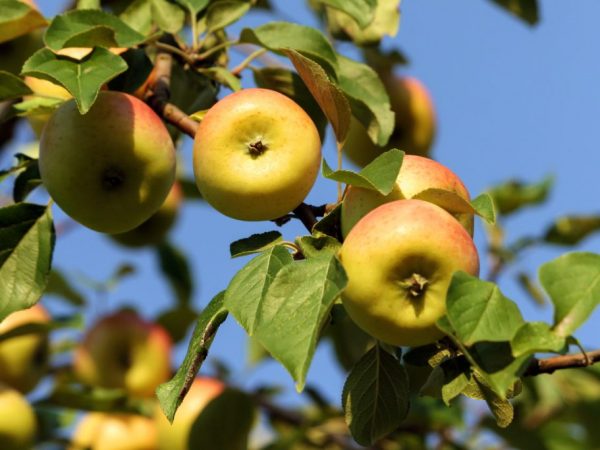
Winter-hardy apple trees: the best varieties
The best varieties
Among the general variety, gardeners distinguish some of the best varieties that have good and stable fertility rates, high immunity against diseases and resistance to cold weather.
Arkadik
An early summer plant of domestic selection with high scab resistance. A tree with a 10-meter conical crown gives large fruits weighing from 200 to 350 g, white-green in color with pronounced red stripes.
The main advantages are intensive growth, high yield, the ability to grow in more severe climatic conditions.
Strafling
Late summer hybrid of the Baltic selection, pleases with tasty, sweet yellow fruits with a reddish barrel.
Trees of medium height - 7-8 m, with a beautiful, spreading crown, pot-shaped. Apples ripen in late summer or early September.
One of the main advantages - good keeping quality for six months, the crop does not lose its original presentation and taste.
Orlovskoe striped
Medium late variety, developed by domestic scientists. Fruit ripens in early September. Fruits with a red cover are juicy, delicate in taste.
The tree bears fruit for 2-3 years of cultivation, has good immunity against scab.
Bogatyr
One of the best late-ripening hybrids of Michurin breeding with a long keeping quality - fruits are stored until summer. The main cover is green, hard, juicy, sweet and sour inside.
Scab-resistant trees have good winter hardiness and fertility.
Sinap Orlovsky
One of the best late winter varieties, great for growing in the Moscow region, the Middle and Central strip.
Fruit picking is carried out in late September or early October. The best taste appears one month after removal.
This apple tree does not have a high yield, but the fruits ripen large, are practically not damaged by pests and diseases, and have a pleasant aroma and taste.
Summer varieties
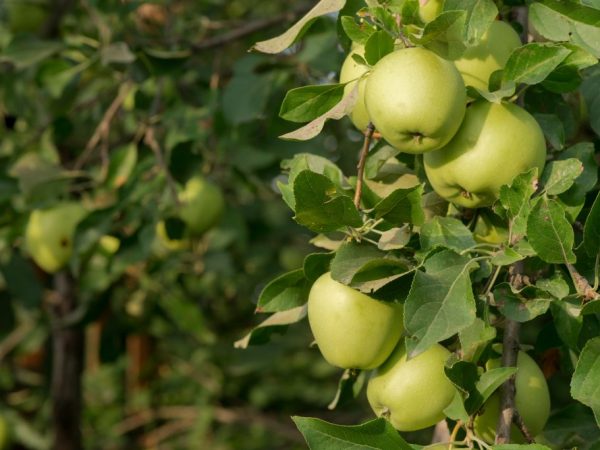
Apples from early varieties must be processed immediately
Summer apple trees ripen from the end of July to the last decade of August. They are not stored for a long time, so after harvesting they are allowed to be recycled.
Folding
It enters the fruiting phase in the 5th or 6th year of cultivation.
The description of the culture includes several distinctive qualities:
- spherical crown;
- conical apples, straw-yellow color, size - 70-85 g;
- the pulp is tender, medium juiciness.
Fruits will remain on the tree for a long time in rainy weather, in heat and drought they are massively crumbled. The plant has a weak immunity against scab, it often freezes in winter, therefore it needs good insulation.
Grushovka Moscow
This tree with a pyramidal crown, bred by folk breeders, tolerates any temperature extremes, therefore it is ideal for cultivation in the Moscow region.
The apple tree can please the first fruits for 5 or 6 years after planting. Small apples - 45-50 g, with a light green cover and a bright pink blush. Very sweet, juicy with a slight sourness.
Ripening occurs in August. Subject to all the rules of agricultural technology, the plant gives a bountiful harvest.
Among the shortcomings, there are massive shedding of fruits, weak resistance to scab.
Pearl
A compact, medium-sized crop with good winter hardiness, ripens in August. The apples are yellow-golden, with white and juicy flesh.
The shelf life of the fruits is about a month.
White Astrakhanskoe
One of the oldest summer varieties, the main advantages of which include intensive growth and high frost resistance.
The first bountiful harvest can be expected 6-7 years after the seedling is planted. The apples are medium in size, juicy, with a slight wine aroma.
It is appreciated for its uniform and stable fruiting every year.
Mantet
A hybrid of American selection with medium vigor. Differs in a beautiful pyramidal, spreading crown.
The annual yield is high. Fruits are spherical, slightly flattened on top, with a yellow-green cover and a bright red blush. Inside contains creamy, juicy, sour-sweet pulp. The crop is not suitable for long-term storage.
Of the shortcomings, they are distinguished - massive shedding after ripening and weak immunity against scab.
Terentyevka
Summer trees have increased frost resistance, stable and good fertility. The first crop is given in the fifth year of cultivation.
Fruits are small - weighing 35-50 g, green with a red stripe, sweet and sour.
Candy
A variety of domestic selection, tall, fast-growing with an early fruiting period - it gives the first fruits in the second or third year of cultivation.
Summer apples of average weight - from 80 to 120 g. Sweet, with tender pulp. Yellow with striped blush, shelf life for about two months.
The plant is appreciated for its good frost resistance and high immunity against diseases.
Autumn varieties
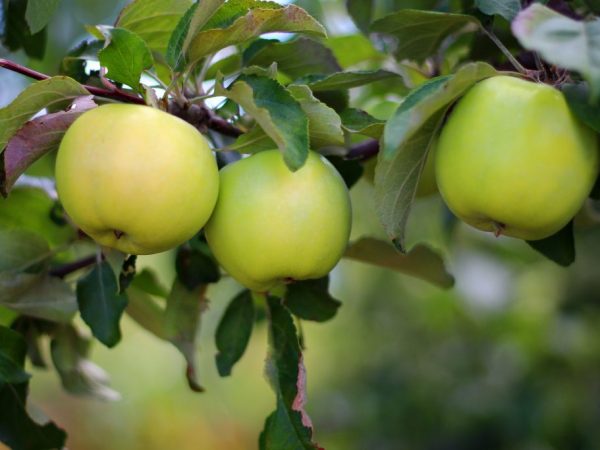
The fruits of apple trees of autumn varieties can be stored fresh for a long time.
This group is made up of varieties that give a tasty harvest of fruits with good keeping quality - until the middle of winter.
Apples are consumed fresh, processed or left for long-term storage.
Cinnamon new
Scab-resistant, rounded trees begin to bear fruit in the sixth year of cultivation.
Small fruits - 130-150 g, spherical, yellow-green with a burgundy blush. Harvesting is carried out in early September.
Auxis
A compact tree with a small, ovoid crown, it belongs to varieties with an average degree of frost resistance and good immunity against scab.
The fruits are not very massive (from 100 to 170 g), sweet and sour, with a yellow-green cover with a bright pink or reddish blush.
The first crop appears in 4-5 years of cultivation.
Zhigulevskoe
One of the oldest winter-hardy varieties of apple trees with a low, dense and pyramidal crown.
It gives the first fruits in the 5th year after planting the seedling. It is appreciated for stable and good fertility every year.
The apples are spherical, juicy, yellow, with a red blush on the barrel. Weight - 130-200 g. The harvest is excellently preserved until January.
Bessemyanka Michurinskaya
A vigorous apple tree with a spreading crown, gives the first fruits in the 7th year. Apples, juicy, spherical, weighing from 100 to 130 g. The cover is straw-yellow with a striped red barrel.
Trees of this variety perfectly tolerate wintering in the Moscow region and other regions with a harsh climate, they are practically not damaged by scab.
Young Naturalist
The apple tree is of medium height and excellent winter-hardy qualities. Immunity against scab is high.
Fruits are round, slightly flattened, yellow-green with a purple barrel, sweet and sour, very juicy. Weight - 100-120 g.
Stored for about two months, ripen in September.
Winter varieties
These are the most valuable winter-hardy varieties. The harvest can be preserved until spring, while marketability, useful properties and taste are not lost.
Scarlet anise
Gives a stable harvest annually, starting from the 6th year of planting. It is rarely affected by scab.
It is characterized by strong growth and a rounded, slightly spreading crown. Average weight of fruits - 55-65 g. Color - greenish-yellow with a pronounced burgundy blush.
The collection is carried out in the last decade of September. They are stored for 3-4 months.
Rossosh striped

The variety is distinguished by large fruits.
An excellent variety for the Moscow region with high winter hardiness, productivity and delicious fruits. The first apples ripen in 5-6 years.
The fruit is large - up to 350 g. The shape is round, the color is pale green with a red barrel. Inside, light green, juicy, sweet and sour.
Harvesting is carried out in October, stored until spring.
Peaceful
The tree perfectly tolerates the strongest and most prolonged frosts, therefore it is cultivated in all regions of our country. The yield is high, annual, the first fruits can be enjoyed in 5-7 years. It is rarely affected by scab.
The apples are large - 150-170 g in weight, round, greenish-yellow with a red tint, slightly sour.
Harvesting is carried out in October, the harvest is stored until March.
Aport Alexander
Possesses an average degree of frost resistance. The crown grows rapidly and strongly, taking on a round, spreading and wide shape.
Apples of this variety are very large - they reach 500-600 g in weight, conical, yellow with burgundy-red stripes on the barrel.
The pulp is loose structure, with increased juiciness and aroma, the taste is sweetish-sour. The picking is carried out in October, stored until March.
Columnar varieties
The advantage of such plants is the compactness of the crown, which allows you to grow several trees at once in a small garden area.
Columnar apple trees are autumn and winter, they safely endure wintering in the Moscow region.
Baby
Autumn variety with medium height and small fruits - weight 60-65 g. The apples are light green or pale yellow with a creamy, sweet insides.
Stored for several months, the best taste appears 2-3 weeks after removal.
Triumph
Medium-sized variety, above-ground part in the form of a pyramid, weakly branched. The apple tree gives not too large fruits - a mass of 120 g, with a slightly ribbed surface, emerald tone.
This culture is excellent for cultivation in the Moscow region, the Volga region, the Central and Middle strip.
Vasyugan
Columnar apple trees with a dense, pyramidal shape, give small fruits weighing 110-120 g. The crown is rounded, the color is white with a reddish, blurred tint.
It is valued for its early fruiting, which begins in the 2nd year of life. The plant tolerates severe frosts and drought well.
Moscow necklace
Slow growing winter hybrid, yields first fruits in the second year of planting. The apples are green with a slightly pronounced pink barrel, the average weight is 120-130 g.
The pulp is not too firm with a sweet-sour taste.
Ostankino
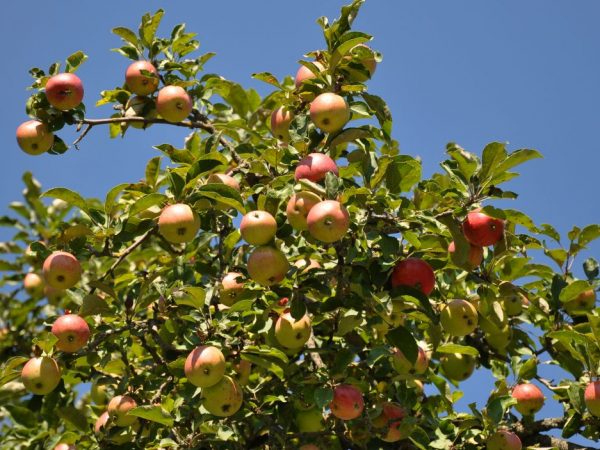
The Ostankino variety will delight you with a delicious harvest
Early winter medium-sized culture with beautiful fruits weighing up to 110 g.
The shape is spherical, flattened, slightly ribbed, the color is light yellow with a rich blush. The taste is fully revealed two weeks after harvest.
The main plus of apple trees is excellent winter hardiness, the disadvantage is poor scab resistance.
Dwarf
This group includes plants with a small crown - 2-4 m in height with annual fruiting and excellent taste.
Melba
This is one of the best self-fertile hybrids in Canadian breeding. Summer dwarf apple trees give their first harvest in the third year. The collection is carried out in the last decade of July.
Fruits have good marketability, weight - 150-250 g, rounded or slightly elongated, the main cover is lime color with yellow strokes. Three months are saved.
Glory to the Winners
The ripening of the crop in the Moscow region falls on the first decade of September. Apples have different weights - from 120 to 180 g. The shape is spherical, the color is yellowish-green with a scarlet blush. Inside the beige tone, juicy and sweet and sour.
In addition to these varieties, other dwarf hybrids are in demand - Grushovka Moskovskaya, Zhigulevskoe, Streyfling, Konfetnoe, Bogatyr, the description of which is presented above.
What to choose for the southern zone
When buying seedlings for growing in the southern regions, be sure to familiarize yourself with their species.
This requirement is due to the peculiarity of the culture - not all varieties grown in the North and in the Middle Lane are suitable, since during the first recurrent frosts they may die.
Ideal for:
- Bujor;
- Babushkino;
- Renet Simirenko;
- Arkad is yellow;
- White filling;
- Golden;
- Glory to the Winner.
These crops are distinguished by annual and stable productivity, they tolerate sharp weather changes in spring well - they practically do not freeze and have a high resistance to sores.
What to choose for the North
Choosing winter-hardy apple trees for a harsh zone, you should give preference to varieties with a high degree of frost resistance.
The first place is given to trees that can withstand severe frosts down to -42 ° С - Skala and Gift to Grafsky.
They are followed by cultures that do not freeze at -35 ° C:
- Lighthouse Zagorje;
- Marat Busurin;
- Young Naturalist;
- Imrus;
- Lingonberry;
- Winter beauty;
- People's.
Other varieties that are no less popular among gardeners of the North (they do not freeze at -30 ° C) are Antonovka ordinary, Medunitsa, Solnyshko, Borovinka and Elena.
The above presented varieties are suitable for cultivation not only in the North, but also in the regions of the Central, Middle zone, in the Urals and the Far East.
Growing features
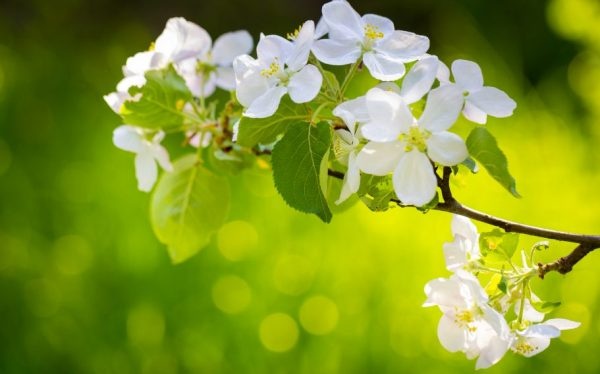
Apple trees need sunshine
The rules for growing fruit trees in regions with harsh climates practically do not differ from the conditions of planting and care in other regions of our country.
Seedling preparation
If you want to get a tree with all the declared varietal characteristics, go to purchase in a horticultural nursery.
Choose specimens with a well-developed, lively crown with a height of 0.5 m. The best seedlings are 1-2 years old with a closed root system. They take root well after transplanting to a new place.
The crown should be healthy without cracks and breaks on the bark, the buds are bright green, the leaves are whole without any spots and inclusions.
Place and soil
Regardless of the variety, apple trees like to grow in a sunny location, where there are no strong winds. The plot is suitable for a flat land with a deep passage of groundwater from 2.5 m.
The tree grows well on loamy or sandy loam soil with a neutral acidity level and a good supply of organic and mineral substances.
Before planting, add a bucket of rotted manure or compost, 3 kg of wood ash, 300 g of superphosphate and 80 g of potassium salt per 1 m².
If necessary, deoxidation add 350 g of calcite, dolomite flour or slaked lime.
Then the soil is dug up and leveled.
Landing technique
The optimal time for planting seedlings in the Moscow region, the Middle, Central strip and in the North is spring (late April or early May). In the south, it can be planted both in spring and early autumn (in September).
Planting holes are dug at a distance, depending on the size of an adult plant:
- for columnar and dwarf - 1x1.5 m;
- medium-sized - 2.5x3 m;
- tall - 3.5x4 m.
The dimensions of the pit depend on the length and width of the earthen coma - approximately 70x80x90 cm.
Drainage from rubble, broken brick or pebbles is laid at the bottom. Then, half of it is filled with a nutrient mixture from a bucket of garden soil, 5 kg of humus, 2 kg of wood ash and mineral fertilizers (100 g each).
The lump is lowered so that the root collar remains above the soil surface. A peg is driven in next to it for support. Fall asleep, tamp, spill water. Consumption per seedling - 10 liters.
Then they huddle with garden soil or rotted manure.
Care requirements
The main care of apple trees consists of several activities.
Watering
It should be frequent and regular for young plantings, which will favorably affect the growth and development of the aboveground and underground parts.
Frequency - once every two weeks, subject to dry summer.
Grown trees are watered 4-5 times per season - in early spring, before and after flowering, at the stage of pouring fruits and in the fall a month before the onset of stable cold weather.
Loosening and mulching
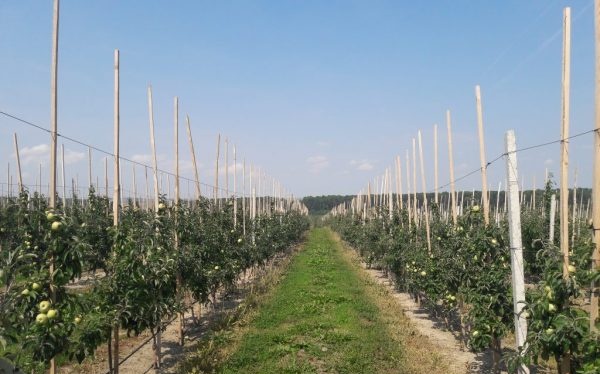
The ground under the apple trees needs to be loosened periodically.
The soil in the near-stem zone is loosened a day after moistening to ensure good access of moisture and oxygen to the roots.
Also, in order to avoid quick drying out, mulch with a thick layer of earth.
Top dressing
The first fertilizer is applied in the third year of life. In the spring, nitrogen agents are used (nitrophoska, ammophoska or urea): 15 g of the substance is dissolved in 10 liters of water.
Then they are fed twice before flowering and at the stage of pouring the fruits with a mineral complex of superphosphate and potassium nitrate - 15 g per bucket of water.
Additionally, the tree can be sprayed with Ovary before budding to increase the yield.
Pruning
The procedure is carried out immediately after planting - the main conductor is shortened by 20 cm in length, which will stimulate the development of lateral branches.
The next year, in the spring, the central branch is re-pruned by 15 cm and the adjacent shoots by 20 cm.
In the third year, all young growth is removed, leaving 3 in the lower and 2 branches in the upper row. The main harvest of the tree will be formed on them.
During the formation, they carry out a sanitary haircut - they cut off the frozen, wind-damaged diseases, as well as shrunken parts. Places of cuts are treated with a solution of copper sulfate, then covered with garden var.
Fight against disease and mediators
For the prevention of diseases and parasites, double treatment with fungicides and insecticides, respectively, is required.
The crown is irrigated in early spring and late autumn, after leaf fall.
Thanks to modern breeding, many zoned apple varieties have been bred for different climatic latitudes.
If you follow the simple rules of planting, care, you can easily and successfully grow a healthy tree on the site, which will delight you with a tasty and aromatic harvest every year.

